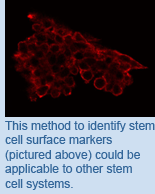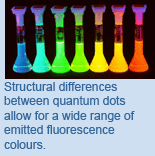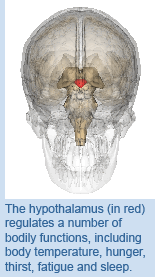
March 2012
Welcome to Net Results EXPRESS
Net Results EXPRESS (NRx) is an award-winning, monthly e-newsletter highlighting medical and scientific breakthroughs, major grants and honours awarded, and other research-related events at UHN. Through NRx you can read about ongoing research at our five research institutes, the Ontario Cancer Institute (OCI), the Toronto General Research Institute (TGRI), the Toronto Western Research Institute (TWRI), the Toronto Rehabilitation Institute (TRI) and the Techna Institute for the Advancement of Technology for Health (Techna). We hope you will find this newsletter informative and helpful. If you have feedback or questions, please contact www@uhnresearch.ca. Christopher J. Paige, PhD, FCAHS |
Stroke: Development of World’s Most Advanced Neuroprotective Drug
In a study published in Nature, TWRI Senior Scientist Dr. Michael Tymianski has demonstrated the neuroprotective effects of a drug in treating stroke in a lab setting. During a stroke, regions of the brain are deprived of blood and oxygen, causing a complex sequence of chemical reactions in the brain that lead to neurological impairment or death. The drug, known as a postsynaptic density (PSD95) inhibitor, prevents the occurrence of these neurotoxic reactions. The study examined the effect of the PSD95 inhibitor in an experimental primate model of stroke which bears genetic, anatomic and behavioural similarities to humans. Animals that were treated with the PSD95 inhibitor after a stroke had greatly reduced brain damage and preservation of neurological function. These improvements were observed in different scenarios. Specifically, when the treatment was given three hours after stroke, the animals exhibited remarkable recoveries. Benefits were also observed when the drug therapy was combined with conventional therapies aimed at re-opening blocked arteries to the brain. Similar effects were observed even in a time window when conventional therapies no longer have an effect. "We are closer to having a treatment for stroke than ever before," says Dr. Tymianski. "We believe that we now have a way to dramatically reduce the damaging effects of stroke and our next step is to confirm these results in a clinical trial." Treatment of stroke with a PSD-95 inhibitor in the gyrencephalic primate brain. Cook DJ, Teves L, Tymianski M. Nature. 2012 February 29. [Pubmed abstract] This work was supported by the Canadian Stroke Network, the Heart and Stroke Foundation of Ontario. Dr. Tymianski is a Tier I Canada Research Chair in Translational Stroke Research. |
Proteomics: A Novel Method to Identify Stem Cell Types
In a collaborative study, OCI Scientist Dr. Thomas Kislinger and The Hospital for Sick Children Senior Scientist Dr. Janet Rossant have recently proposed a novel technique to overcome this hurdle. They employed a cell-surface labeling strategy coupled to proteomics analyses, where protein structure and function is studied, to identify unique proteins on the surface of stem cells. This approach enabled the isolation of specific stem cell types directly from mouse blastocysts—cell structures formed during the initial embryo phase. In all, 27 cell-surface proteins with specific roles in early development were validated and, for the first time using this strategy, stem cell surface protein signatures were identified. "This research provides crucial information regarding the differences in expression of important cell-surface proteins and receptors, information that can be used to understand lineage development, differentiation and reprogramming," explains Dr. Kislinger. "We have enabled new approaches to understanding the mechanisms that regulate cell fate specification." Cell-surface proteomics identifies lineage-specific markers of embryo-derived stem cells. Rugg-Gunn PJ, Cox BJ, Lanner F, Sharma P, Ignatchenko V, McDonald AC, Garner J, Gramolini AO, Rossant J, Kislinger T. Developmental Cell. 2012 March 14. [Pubmed abstract] This work was supported by the Heart and Stroke Foundation of Ontario, the Canadian Institutes of Health Research and The Princess Margaret Hospital Foundation. Dr. Kislinger is a Tier II Canada Research Chair in Proteomics in Cancer Research. |
Medical Imaging: Novel Tools for Visualizing Tumours Using Nanotechnology
To address these issues, Techna Co-Director of Photonics and OCI Senior Scientist Dr. Brian Wilson and colleagues examined a number of clinically-relevant factors essential for the use of QDs. Using four QDs that emit light at different wavelengths, they determined the optimal dosage range of the QDs to effectively visualize vascularized tissue—a criteria that will be useful for imaging tumours. The study also determined that the time taken for the QDs to be cleared from the vascularized tissue fell under a range of 2-5 hours, which is sufficient time to acquire an accurate image. Commenting on these findings, Dr. Wilson says, "This study demonstrates, for the first time, optimization of QD imaging in a live tissue system. We have provided critical guidelines for optimizing QD imaging that will benefit future developments and applications." Estimation of minimum doses for optimized quantum dot contrast-enhanced vascular imaging in vivo. Roy M, Niu CJ, Chen Y, McVeigh PZ, Shuhendler AJ, Leung MK, Mariampillai A, Dacosta RS, Wilson BC. Small. 2012 March 19. [Pubmed abstract] This work was supported by the Canadian Institutes of Health Research, the Ontario Ministry of Health and Long-Term Care and The Princess Margaret Hospital Foundation. |
Metabolism: Appetite Control in the Brain
A recent study by TGRI Affiliate Scientist Dr. Denise Belsham demonstrated that administration of a highly stable form of GLP-2 directly to the brain resulted in an immediate suppression of food and water intake, causing weight loss within two hours. Additionally, neurons in the hypothalamus increased production of the appetite-regulating hormones neurotensin and ghrelin. "Our results indicate that GLP-2 can control appetite directly through action in the hypothalamus," says Dr. Belsham. "Development of therapeutics that can mimic the effects of GLP-2 could serve as the next-generation of appetite control interventions." Glucagon-like peptide-2 directly regulates hypothalamic neurons expressing neuropeptides linked to appetite control in vivo and in vitro. Dalvi PS, Belsham DD. Endocrinology. 2012 March 13. [Pubmed abstract] This research was supported by the Canadian Institutes of Health Research, the Canadian Diabetes Association, the Canada Foundation for Innovation. Dr. Blesham is a Tier II Canada Research Chair in Neuroendocrinology. |
Rehabilitation: Psychotherapy Promotes Prolonged Benefits in Patients with Brain Injury
Seventeen patients with long-term ABI, nine years after initial injury, were provided with eleven CBT sessions, in either group therapy or telephone formats. Psychological assessments and community integration questionnaires were provided before and after CBT, as well as at a six month follow-up appointment. Psychological distress and community integration significantly improved six months after the CBT sessions, indicating a sustained benefit from therapy. "The findings are promising as they suggest that even a brief intervention a decade after the initial injury can have lasting benefits," says Dr. Green. "Interestingly, this study supports the use of CBT via telephone, known as teletherapy, potentially increasing accessibility to and reducing costs of psychotherapy." Cognitive behavior therapy after acquired brain injury: maintenance of therapeutic benefits at 6 months posttreatment. Arundine A, Bradbury CL, Dupuis K, Dawson DR, Ruttan LA, Green RE. Journal of Head Trauma Rehabilitation. 2012 March-April. [Pubmed abstract] This research was supported by the Ontario Neurotrauma Foundation. Dr. Green is a Tier II Canada Research Chair in Traumatic Brain Injury. |
UHN Licensed Image Guided Irradiator System Reaches 10th Installation Milestone
Invented and developed at UHN by Techna Director and OCI Senior Scientist Dr. David Jaffray and OCI Senior Scientist Dr. Richard Hill, the system combines cone-beam CT imaging technology with X-ray irradiation capability. The integration of these two capabilities allows for sub-millimeter targeting accuracy to high-dose pre-clinical radiation therapy research. “This work came about from UHN’s own need of having pre-clinical cancer research tools which mirror image guided radiation therapy treatments done in the clinic,” says Dr. Jaffray. The X-RAD 225Cx was commercialized by Mark Taylor through UHN’s Technology Development and Commercialization Office in 2009 using a medical technology-specific model for public-private partnership. "We have worked hard to create an environment where our expertise in the health-technology area is translated into marketable product as quickly as possible," says Mr. Taylor. "It is about providing a sustainable enterprise enabling the development of new features and new discoveries." Technology development activities are being lead by Techna in partnership with local partners for the next generation development of the system. NIH/NCI joins a growing number of international research institutions who have purchased the X-RAD 225Cx, including the Netherlands Cancer Institute, Maastricht University, Dana-Farber Cancer Institute, Duke University and the University of Texas Southwestern Medical Centre. |
 |
![]()
 Dr. Benjamin Neel has been elected to serve on the American Association for Cancer Research (AACR) Board of Directors. As a member of this board, Dr. Neel will set general policy for the Association and oversee its activities, representatives and employees. He will also serve as the Chairperson of the 2012 AACR Annual Meeting.
Dr. Benjamin Neel has been elected to serve on the American Association for Cancer Research (AACR) Board of Directors. As a member of this board, Dr. Neel will set general policy for the Association and oversee its activities, representatives and employees. He will also serve as the Chairperson of the 2012 AACR Annual Meeting.AACR is the world’s first and largest professional organization dedicated to advancing cancer research and to prevent and cure cancer. Its membership includes 34,000 laboratory, translational and clinical researchers, population scientists, health care professionals and cancer advocates in more than 90 countries.
 UHN congratulates Dr. Thomas Kislinger on the renewal of his Tier II Canada Research Chair (CRC) in Proteomics in Cancer Research.
UHN congratulates Dr. Thomas Kislinger on the renewal of his Tier II Canada Research Chair (CRC) in Proteomics in Cancer Research.Dr. Kislinger's CRC will provide funding over the next five years to support his research program, which is aimed at using proteomics to identify biomarkers and molecular mechanisms of epithelial ovarian cancer. His research will help develop tools to improve the diagnosis of this cancer.
 Dr. Daniel Winer received the Benjamin Castleman Award from the Massachusetts General Hospital and the United States and Canadian Academy of Pathology.
Dr. Daniel Winer received the Benjamin Castleman Award from the Massachusetts General Hospital and the United States and Canadian Academy of Pathology.This award is granted for an outstanding paper in the field of human pathology by a pathologist under the age of 40. Dr. Winer’s paper titled, “B cells promote insulin resistance through modulation of T cells and production of pathogenic IgG antibodies” was published in the May 2011 issue of Nature Medicine.
 TGRI Affiliate Scientist Dr. Brain Hodges was recognized by the Canadian Association for Medical Education (CAME) with the 2012 Ian Hart Award for Distinguished Contribution to Medical Education for his contributions across the continuum of medical education to advancing medical education in Canada and internationally.
TGRI Affiliate Scientist Dr. Brain Hodges was recognized by the Canadian Association for Medical Education (CAME) with the 2012 Ian Hart Award for Distinguished Contribution to Medical Education for his contributions across the continuum of medical education to advancing medical education in Canada and internationally. Dr. Hodges was praised for his dedication to excellence in teaching, and the impact he has had on clinicians, educators and researchers involved in medical education and education research in Canada and around the world.
Feedback
Net Results EXPRESS is brought to you by UHN Research Communications. We hope you have enjoyed receiving this message. If you have any feedback, please email www@uhnresearch.ca.
To access archived issues of Net Results EXPRESS, visit uhnresearch.ca/news/netresultsexpress
Some images adapted from the image archives of stock.xchng.ca, Wikipedia and Dr. Thomas Kislinger. There has been a tremendous focus on the use of stem cells in finding a cure for a number of degenerative diseases. The hope is that transplanted stem cells will compensate for cell deficiencies that underlie existing disease conditions, in part due to these special cells’ unique ability to develop into a wide variety of specific cell types. However, the capacity to isolate a particular stem cell—the first step towards understanding how each cell fate is determined and how it can be utilized in the body—has been a shortcoming in the field.
There has been a tremendous focus on the use of stem cells in finding a cure for a number of degenerative diseases. The hope is that transplanted stem cells will compensate for cell deficiencies that underlie existing disease conditions, in part due to these special cells’ unique ability to develop into a wide variety of specific cell types. However, the capacity to isolate a particular stem cell—the first step towards understanding how each cell fate is determined and how it can be utilized in the body—has been a shortcoming in the field. Quantum dots (QD) are stable nano-sized crystals capable of emitting fluorescent light. Recent advances have led to the development of QDs suitable for medical use, making them a potential new approach for cancer detection and image-guided treatments. The different colours of emission can be used to make a ‘cocktail’ that would reveal multiple different cancer biomarkers at the same time. However, the optimal dose of QDs in tumours is unknown and without this information the technical feasibility and possible cost and toxicity of quantum dot-based imaging is unknown.
Quantum dots (QD) are stable nano-sized crystals capable of emitting fluorescent light. Recent advances have led to the development of QDs suitable for medical use, making them a potential new approach for cancer detection and image-guided treatments. The different colours of emission can be used to make a ‘cocktail’ that would reveal multiple different cancer biomarkers at the same time. However, the optimal dose of QDs in tumours is unknown and without this information the technical feasibility and possible cost and toxicity of quantum dot-based imaging is unknown. Appetite is controlled through a complex relationship between the digestive system and the part of the brain called the hypothalamus. Secretion of various hormones and proteins from the hypothalamus results in a number of different appetite responses in the intestine. In particular, glucagon-like peptide 2 (GLP-2) is known to control appetite at the level of the digestive system, however little is known about the role of GLP-2 at the level of the hypothalamus.
Appetite is controlled through a complex relationship between the digestive system and the part of the brain called the hypothalamus. Secretion of various hormones and proteins from the hypothalamus results in a number of different appetite responses in the intestine. In particular, glucagon-like peptide 2 (GLP-2) is known to control appetite at the level of the digestive system, however little is known about the role of GLP-2 at the level of the hypothalamus. The initial stages of rehabilitation in patients with acquired brain injury (ABI)—a brain injury that occurs after birth and is not congenital or progressive—focus on cognitive and physical symptoms. However, psychological symptoms, such as depression and anxiety, are often left unaddressed at this stage. These symptoms can persist for years and are associated with poor recovery and decreased quality of life. TRI Senior Scientist Dr.
The initial stages of rehabilitation in patients with acquired brain injury (ABI)—a brain injury that occurs after birth and is not congenital or progressive—focus on cognitive and physical symptoms. However, psychological symptoms, such as depression and anxiety, are often left unaddressed at this stage. These symptoms can persist for years and are associated with poor recovery and decreased quality of life. TRI Senior Scientist Dr.  UHN, in partnership with Precision X-Ray Inc., has installed the 10th unit of the pre-clinical Image Guided X-Ray Irradiation System, the X-RAD 225Cx, at the National Cancer Institute (NCI), part of the National Institutes of Health (NIH). The X-RAD 225Cx is a platform which enables the image-guided placement of irradiation distributions within pre-clinical subjects.
UHN, in partnership with Precision X-Ray Inc., has installed the 10th unit of the pre-clinical Image Guided X-Ray Irradiation System, the X-RAD 225Cx, at the National Cancer Institute (NCI), part of the National Institutes of Health (NIH). The X-RAD 225Cx is a platform which enables the image-guided placement of irradiation distributions within pre-clinical subjects.